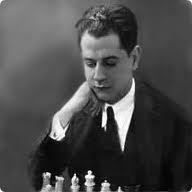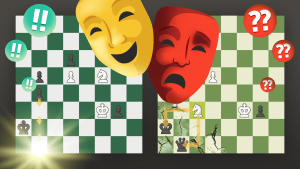
The weak, "strong" e4-pawn
Before I explain the strange title of today's article, let me show you what kind of position we are going to discuss:
This kind of position can happen in many different openings (we can assume that there are many more pieces besides pawns in the position) after Black 'surrenders' the center by an e5 x d4 trade of the central pawns. At first it looks like White should have a clear advantage due to his strong presence in the center and spatial advantage marked by the e4 pawn. You can find many games that argue this point and the next classical and very famous game is one of them:
This game has a funny story. Since it was a super tournament, only players who won some major tournaments in the past were invited. The only exception was Capablanca who was just a rising star at that point, but he was invited since the organizers could see that he had a very bright future. Some of the participants were strongly against Capablanca's participation in the tournament and Bernstein was one of them. The game Capablanca - Bernstein played in the very first round silenced the doubters.
Anyway, it was easy to see the numerous advantages of the strong central e4 pawn and therefore the e5xd4 trade that 'surrenders' the center was called a positional mistake by many top authorities of that time. However, if you are open minded enough to look at the position without bias, you can notice some positive sides of Black's position as well. Of course, I am talking about use of the 'e' file. Also, if you take into the account that the 'strong' e4 pawn is located on this exact open file, you can easily imagine some situations where such a pawn can become a liability. One of the first examples of such 'out of the box' thinking can be found in the next classical game. Look at the next diagram and count how many Black pieces attack the poor e4 pawn!
Games like this led to a revolution in positional understanding. If old masters (around Capablanca & Rubinstein's time) saw a currently theoretical position from the Fianchetto variation of the King's Indian, they would probably call it strategically winning for White. Judge for yourself:
But many strong Grandmasters like Boleslavsky, Geller and especially Bronstein have proved that the position is absolutely playable for Black. We analyzed two classical Bronstein games in this system here:
http://www.chess.com/article/view/kings-indian-defense-according-to-bronstein
This positional concept of the strong central e4 pawn being very weak sometimes is very well known now, and yet sometimes even very strong chess players fall for it. The next game from a Candidates Match is a good example. Spassky was on his way to the World Champion title, yet his loss looks very similar to the Tarrasch-Chigorin game we analyzed above:
As you could see, Spassky didn't lose his central e4 pawn, but he had to defend it with almost all of his pieces, which made them very passive. So it is a difference in the activity of the White and Black pieces which eventually caused his defeat.
The next game of a young Alexey Shirov shows a similar situation:
As you can see, the central e4 pawn can be both an asset and a liability, it all depends on the position. I hope that after reading this article, your own central pawns will always remain strong and if it is your opponent who has such a pawn, he will regret it! 
Good luck!

